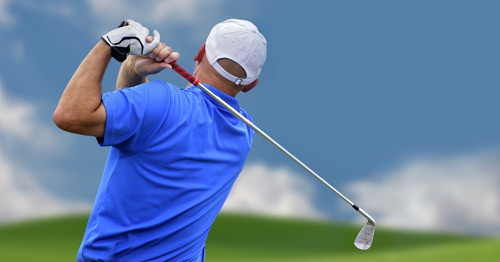Golfer's Elbow
Golfer's elbow is one of the most common golf injuries. Technically called medial epicondylitis, it is an inflammation of the tendons that attach your forearm muscles to the bone on the inside of your elbow. It is common among beginners in golf, but it can result from many kinds of repetitive arm motion, such as hammering or throwing. Golfer’s elbow is similar to tennis elbow (lateral epicondylitis), which is inflammation of the outside of the elbow joint.
What is golfer’s elbow?
Golfer's elbow is the inflammation of the tendons that attach the muscles of the forearm to the bone on the inside the elbow joint. The condition is usually caused by repeated, strenuous arm movement.
Golfer's elbow is most common in the right elbow of a right-handed novice golfer. Those who develop the condition often have an incorrect weight shift and tend to “throw the club down” at the ball. This is sometimes referred to as "hitting from the top." This can increase the stress on the muscles on the inside of the forearm. Specifically, there is increased muscle activation of the pronator teres, an inner forearm muscle, during the acceleration phase of the swing. Transferring your weight smoothly from your back to your front foot while keeping your shoulders level will ensure proper contact between the club face and the ball.
Golfer's elbow can also develop in the left arm of a right-handed golfer if their follow-through is generated by turning over the wrist. In these cases, there is increased strain on the inside of the left elbow as the golfer's wrist turns palm-up.
What are the symptoms of golfer’s elbow?
The most common symptom is inner elbow pain and/or pain in the inside of the forearm, but feelings of stiffness, weakness and/or tingling may also occur. Pain and tenderness are usually felt on the inner side of the elbow, but may also spread to the forearm and wrist.
How do you prevent golfer’s elbow?
A number of factors play a role in preventing this injury. Stretching, using proper equipment and maintaining proper swinging form will help prevent injury. New golfers should consider lessons and club fitting to avoid excessive strain. During the off-season, a balanced training program can be helpful to improve the mobility and strength necessary to complete the golf swing. Early in the golf season it is important to be mindful of a gradual progression of swing volume to avoid doing too much too quickly. Warm up and stretch appropriately before playing, and listen to your body. Don’t make what could be a relatively minor condition into something more severe by playing through pain.
To warm up your elbows and forearms, do the following exercises on the course before you begin playing. They will prepare your muscles and promote ideal mechanics to help prevent injury and improve your performance.
Forearm rotation
- Stand with your elbows bent at your sides. Keep your elbows close to your body.
- Rotate your forearms, palms-up then palms-down.
- Perform 5 to 10 repetitions using slow, controlled movements.
Forearm stretch
- Stand with one arm directly in front of you with your elbow straight and palm upward.
- Bend your wrist so that your fingers point toward the ground.
- Apply a stretch to your palm with your other hand. Stretch just until you feel a slight pull in your forearm but not pain.
- Repeat with your palm facing down.
- Hold each stretch for 15 seconds.
- Perform on both sides.
Golfers with a history of golfer's elbow can consider wearing a forearm band below the elbow to reduce strain. Grip size can have an impact on your elbow mechanics, especially for beginners who may not have developed proper form, and in older golfers. If you’re having elbow pain, try to increase the width of your grips or change your grip position. Oversized, soft grips can help to reduce compressive forces and pressure when holding a club, and this can help prevent golfer’s elbow. If you feel that you are really trying to hold your club tightly in your hands, you may be gripping too hard. Your club should lay in your fingers.
How do you treat golfer’s elbow?
The first and most important treatment is to rest the arm. Stop doing the motion that caused the injury. NSAID (nonsteroidal anti-inflammatory drug) pain medications such as ibuprofen should alleviate the pain and help control the inflammation. If pain continues for several weeks despite rest and pain relievers, consult a sports medicine physician.
More chronic cases, and cases that are not responding to the above-mentioned treatment methods, may benefit from an injection of cortisone or platelet-rich plasma (PRP) into the area. Cortisone is a corticosteroid that helps reduce inflammation. Though it may help the symptoms, a concern with cortisone use is that it can potentially weaken muscle and tendon tissue. PRP, which involves isolating of the growth factors from one’s own blood and injecting into the site of maximal tenderness (most significant area of pain), is less damaging to the tendon than cortisone and has been shown to benefit some patients.
Most cases of golfer's elbow resolve with some combination of the conservative options described above, but in about 10% of cases, patients will require surgery. The surgery, known as medial epicondyle release, involves removing the degenerated area of tendon and, if a tear is present, repairing it.
Golf-specific services at HSS
For information on golf specific services at HSS, plese email sportsperformance@hss.edu.
Golfer's Elbow Success Stories
